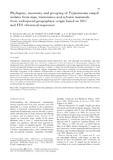Phylogeny, taxonomy and grouping of Trypanosoma rangeli isolates from man, triatomines and sylvatic mammals from widespread geographical origin based on SSU and ITS ribosomal sequences
Abstract
Phylogenetic relationships among Trypanosoma rangeli isolates from man, wild mammals and triatomine bugs from
widespread geographical origin were inferred by comparison of the small subunit of ribosomal gene sequences. The
phylogenetic trees indicated that the subgenus Herpetosoma is polyphyletic and strongly supported division of this group
into two monophyletic lineages, one made up of T. rangeli, T. rangeli-like and allied species and other consisting of T. lewisi
and related taxa. Based on phylogenetic analysis, morphology, behaviour in vertebrate and invertebrate hosts and epidemiology
we propose: a) the validation of Herpetosoma as a taxon comprised only for species of group lewisi and the
maintenance of T. lewisi as the type-species of this subgenus; b) the classification of T. rangeli, T. rangeli-like and allied
species into a ‘T. rangeli-clade’ more closely related to Schizotrypanum than to T. lewisi or T. brucei. The phylogenetic tree
disclosed at least 4 groups within the clade T. rangeli, all confirmed by polymorphism of the internal transcribed spacer,
thus conferring for the first time phylogenetic support to groups of T. rangeli and corroborating the high complexity of this
taxon. Grouping was independent of their mammalian host-species and geographical origin, indicating that other factors
are determining this segregation.
Collections
Información Adicional
| Correo Electrónico | nanes@ula.ve |
| Editor | Parasitology (2004), 129 |
| Colación | 549-561 |






